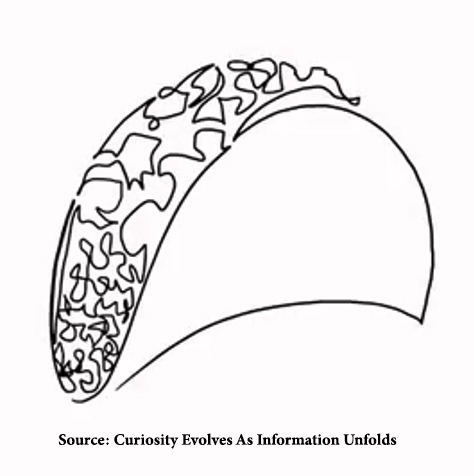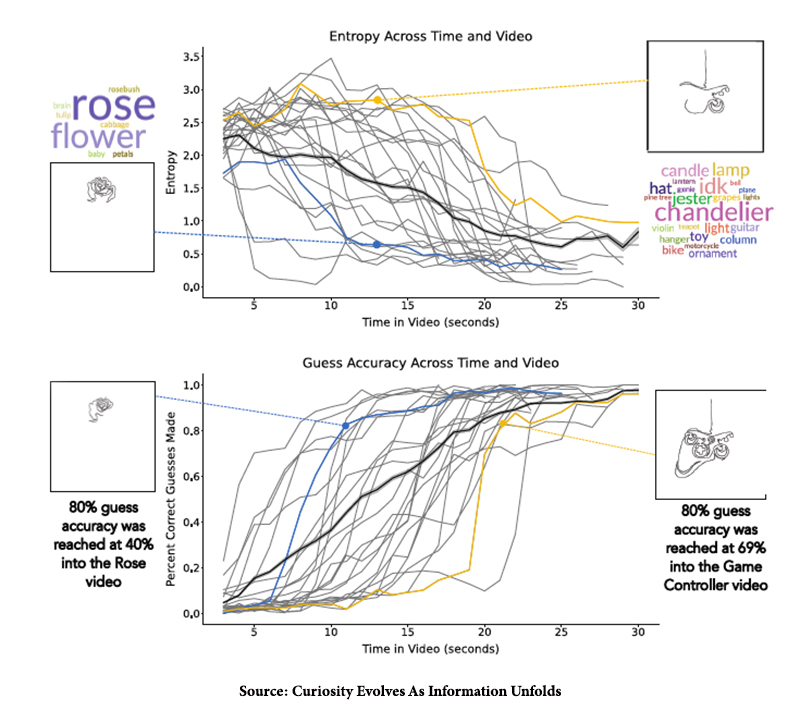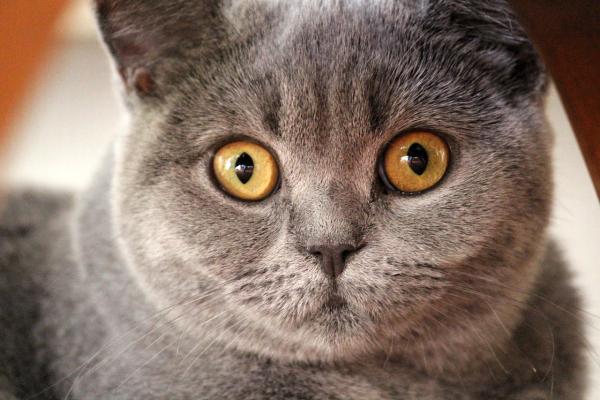I just wrote the other day about willful ignorance, another of our human behaviors, so when I ran across this study in PNAS, I was curious about what they found.
“When we watch TV shows or football games, we’re watching that information evolve over time, uncertain about how it’s all going to end. I wanted to know if higher curiosity would push people to seek, or to avoid, getting an immediate ‘spoiler’.”
Abby Hsiung, Ph.D., Duke Institute for Brain Sciences
The study involved over 2,000 participants who watched 25, 20 to 30-second videos of “line drawings that  slowly resolved into objects.” Mid-video participants were asked what the drawing depicted, their certainty of that guess, and whether they felt “enjoyment, tension, or frustration” at that moment. There was also an opportunity to stop the video and either jump to the “resolution” or simply move on to another video.
slowly resolved into objects.” Mid-video participants were asked what the drawing depicted, their certainty of that guess, and whether they felt “enjoyment, tension, or frustration” at that moment. There was also an opportunity to stop the video and either jump to the “resolution” or simply move on to another video.
The researchers introduced a new metric to express the relationship between the clarity of the image and the drive to get to the puzzle’s solution to quantify curiosity. They termed this the stimulus entropy – a formula incorporating “the number and frequency of unique guesses” by all the participants for an image over time. As clarity to the image emerged, stimulus entropy declined.
 Perhaps now is a good time for a picture to replace a thousand words. A diagram of stimulus entropy in the upper graph shows those dynamic changes over the 30 seconds of each video.
Perhaps now is a good time for a picture to replace a thousand words. A diagram of stimulus entropy in the upper graph shows those dynamic changes over the 30 seconds of each video.
Stimulus entropy was most significant when there was lots of guessing, early in the videos when the line drawing was quite ambiguous. The stimulus entropy declined as the line drawing became more apparent. The bottom graph shows that the accuracy, as you would expect, increased over the same time frame. Everyone went from not knowing to knowing, but as the graph visualizes, there were many different paths to knowing.
The analysis of the pathways allowed the researchers to conclude:
- Curiosity was at a maximum, and stimulus entropy was highest when little information was known.
- Curiosity diminished as confidence in a solution increased.
- Not all individuals “always seek immediate resolution for their curiosity.” For some more highly curious, the experience of gathering information is greater than the need for immediate knowledge. “…higher curiosity may … prioritizing the process of information gathering over hastening the outcome.”
- Curiosity was associated with enjoyment and was greatest at the beginning of the puzzle when the least was known.
- Curiosity was also accompanied by two less enjoyable feelings: tension because of uncertainty and frustration as a solution remains elusive. Curiosity declines as one moves closer to resolution, but so do those dis-comforting feelings.
- In some instances, participants could freely choose when to provide their guess, certainty, and feelings; at other times, it was required, and participants took their “best guess” at the moment. Participants freely choosing when to reveal their understanding used their “certainty” to control the moment - “participants were more likely to continue watching when uncertain and more likely to stop once they believed a resolution was reached.”
“curiosity changed over the course of information gathering, yet consistently discouraged truncating the information-gathering.”
What’s It to Us?
There has been no greater challenge to our curiosity, at least in health, than COVID. The findings of this study may help explain both the public health and our individual responses to many of COVID’s puzzles. For example,
Early in the pandemic, with the large numbers of nursing home deaths and speculation that the infectivity and mortality for COVID were quite high, there was the most significant uncertainty: stimulus entropy was at its height. Despite substantial uncertainty, public health officials had to offer precautions to a fearful public. It was analogous to the participants in the curiosity study being compelled to offer their “best” guess. The tone of their messaging and our prior experience with the value of public health measures provided more certainty than was warranted.
There were valid concerns about the vaccines regarding their efficacy and adverse effects. For those whose prior experience and current concerns made them confident in the public health messaging about vaccines, there was little curiosity, and they lined up for treatment. For others, the faint signal of myocarditis in VAERS, along with their underlying experience and attitudes, was sufficient to become less curious and very confident that the vaccines were harmful. For them, with diminished curiosity, the case was closed, and they would not risk taking the vaccine. On the other hand, for still others, there was a need to continue to gather information and not reach a “hasty” conclusion. These “most” curious individuals carried out additional studies demonstrating that while the vaccine was associated with myocarditis, that impact was less than the cardiac symptoms from COVID.
Some of us have a higher tolerance of uncertainty than others. 30+ years of surgical experience allowed me to act decisively in the presence of significant uncertainty – perhaps “experience” filled the gap. There is tension in the operating room. Whatever problem is before me must be solved before the patient, and I leave the room. The current study demonstrates how those feelings are dynamically related to curiosity. In the presence of significant uncertainty, those most fearful of COVID may choose vaccination, while those equally uncertain but more fearful of possible adverse consequences would skip the jab. In both instances, there would be a reduction in the tension and frustration of not making a choice and resolving their curiosity. Could the vaccine-hesitant, closed off to discussion, have stifled their curiosity to avoid the real discomfort in the tension and frustration of their uncertainty? Action over continued analysis.
Science is always curious. Despite the use of the term Law of this or that, there are no laws; there are beliefs that are more explanatory than others. Science always stays curious. For those of us who are nominally curious but require certainty or are more easily frustrated than others, we jump to the conclusion once we perceive a solution. That is our human behavior. That may be the fundamental underpinning of the Dunning-Kruger effect when those who know the least vastly overestimate their knowledge. This confidence may be born more from a lack of innate curiosity and a fear of uncertainty than any flaw in their thinking.
Source: Curiosity Evolves As Information Unfolds Proceedings of the National Academy of Sciences DOI: 10.1073/pnas.2301974120.




